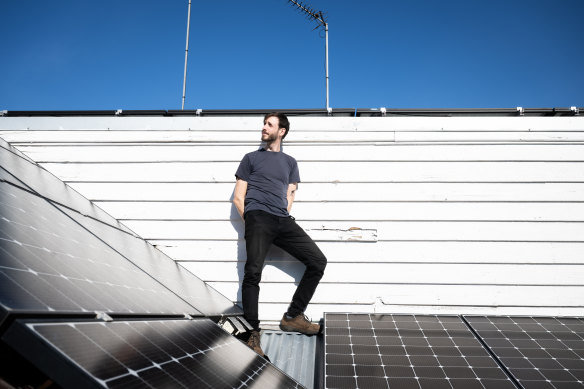Households surge ahead in rooftop solar as renewable projects break bottleneck
Consumers are leading the national transition to renewable energy, installing four times more electricity generation through rooftop solar in the first half of this year than all the commercial projects combined.
Households added 1.3 gigawatts (1300 megawatts) of power capacity to the national electricity grid through 141,364 new rooftop solar installations in the first six months of 2024, a Clean Energy Council report says, while only 310 megawatts of commissioned large-scale generation projects came online during the same period.

Rooftop solar installations are on track to exceed 25 gigawatts of capacity by the end of 2024.Credit: Louie Douvis
SunWiz managing director Warwick Johnston said large-scale solar and wind projects were large investment decisions facing “headwinds” in the planning system, and these same barriers were not there for rooftop solar.
“You’re looking at lots of people making very comparatively small investment decisions on the basis of really just their personal situation,” Johnston said.
“It’s a lot easier to get a permit to connect your solar to the grid, and you don’t need environmental studies or any of those sorts of things when you’re just putting solar on your own roof.”
However, a significant amount of large-scale renewable energy is in the pipeline, and new figures from the Clean Energy Regulator suggest projects are finally passing the bottleneck of approvals.
The Clean Energy Council report, using SunWiz figures for rooftop solar, says NSW became the second state behind Queensland to surpass one million rooftop solar installations, adding 454 megawatts of extra capacity.
Clean Energy Council co-chief policy and impact officer, Con Hristodoulidis, said Australia was a global leader in rooftop solar, in part because of good policy with consumer incentives from both the Commonwealth and state governments for about 12 years.
“The beauty of Australia is we’ve got a high proportion of [freestanding] housing … so the ability for people to put solar on their roof has been a lot easier than some of the other countries that are more apartment-based,” Hristodoulidis said. “And finally, we’ve got some sun.”
The average system size is now 9.7 kilowatts, compared with 7.4 kilowatts five years ago and 4.3 kilowatts a decade ago. Johnston said 20 per cent of solar panel installations in 2023 were upgrades to existing systems.
Australia now has 24.4 gigawatts of installed rooftop solar capacity, compared with 21.3 gigawatts of coal-powered electricity in the 2023-24 financial year.
The report also says about one in five solar installations nationally included a household battery in the first half of the year, adding nearly 30,000 units for a cumulative total of more than 140,000.
Johnston said the uptake of batteries was driven by falling feed-in tariffs, making it more economical to store energy to use later and to ensure an uninterrupted power supply.
“People are sick of sending their solar power out to the grid and only getting a pittance for it, whereas those batteries mean that they can take charge of their own power needs,” Johnston said.
“The other aspect is people seeing increasingly strong weather-related blackouts … and batteries are providing that insurance for their own electricity supply.”
The Victorian government has low-interest loans for household batteries, and NSW has a rebate scheme starting in November. The Clean Energy Council is calling for federal incentives.
The Clean Energy Council figure of 310 megawatts for large-scale renewables counts only generators that started distributing electricity into the grid in the first half of 2024, rather than projects in the approval or construction phase.
The Clean Energy Regulator, in a separate report, said it approved 1.4 gigawatts of large-scale renewable generation in the first half of 2024 and 2.5 gigawatts of applications were awaiting assessment at the mid-point of the year.
The regulator also reported that 1.8 gigawatts of large-scale renewable capacity reached the “financial investment decision” stage in the first half, which means the proponent has committed financial resources and is ready to build.
Minister for Climate Change and Energy Chris Bowen said the figures showed the government’s renewables plan was “on track and building momentum”.
Get to the heart of what’s happening with climate change and the environment. Sign up for our fortnightly Environment newsletter.